

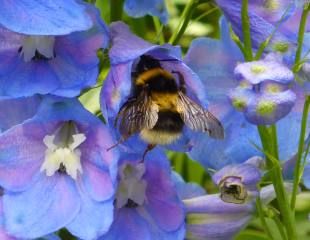
How to Grow Delphiniums
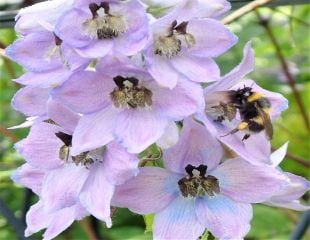
Delphiniums at a glance
- Red Wheelbarrow time consuming to grow
- Need Slug protection
- It is essential to stake and support Delphiniums
- Expect some casualties
- Feeding is optimum but optional.
- Tall, splendid spikes of flower suitable for back of the border.
Delphinium, common name larkspur, is a summer flowering, hardy herbaceous perennial. Delphiniums are tolerant of our winters, H5 hardy, (explanation of frost hardy) and in late autumn the plants die back completely to bare earth and re grow each spring.
Delphiniums are an impressive border plant with tall spires of flowers which bloom in mid-summer. I grow them; I love them, but they are hard work and definitely a red wheelbarrow plant. When growing Delphiniums, there are two areas which need particular attention slugs and support.
Delphiniums grow best in moist, fertile soil in a sheltered spot away from winds. Delphiniums fare best in summers which are cooler, hot dry summers are not ideal, which can exacerbate their tendency towards powdery mildew. Although Delphiniums need sun, they are best not planted in hot spot, morning sun is ideal.
Adding plenty of organic matter into the planting area will help to hold in moisture, as will a mulch. Plant delphiniums level with the existing soil, i.e. not too deep. Delphiniums have hollow stems which support the heavy flower heads. These stems are prone to snapping if there are gusty winds and rain. In good growing conditions and summer weather, Delphiniums can look just fabulous.
Much gardening advice says to water and feed during the growing season. If the soil is reasonable, I find you can get away with not feeding them. Delphiniums will benefit from feeding if time allows, but equally bloom well without being cosseted. Whilst summer feeding may not be essential, staking is. Which means if you don't have time to feed and stake Delphiniums, the more important task is to stake them so the plant and blooms supported.
After flowering, it is best to dead head the flower spike, and further smaller flower shoots should appear. Delphiniums attract bees, partly because of their lovely, strong blue color; bees love blue flowers. Delphiniums are a red wheelbarrow plant as they need attention in terms of slug protection, staking and, if time allows, feeding, as detailed below. If Delphiniums are not your first choice to plant, check out summer flowering plants, scented plants, and climbing plants for more ideas on what to plant in the garden.

Delphiniums are one of the few red wheelbarrow plants on this website. Note: Delphinium plants and seeds are very poisonous to both humans and animals and can lead to severe illness. Check out here a link to RHS link of all poisonous garden plants, which you may wish to avoid.
Delphiniums Slugs and Staking
Slugs are keen on the fresh tender shoots which emerge in the spring. It is essential to use slug protection. There are lots of ways to defeat slugs and click here for ideas on how to beat the slugs.
All Delphiniums need staking as soon as they begin to grow in the spring.
Heavy summer storms or rain can damage the flower heads. The blooms become heavy with the rainwater and it is hard to stake them sufficiently to prevent the stems from snapping, especially if there are high winds.
It is best to stake early. Too late and it can be awkward pushing stakes into the ground next to a delphinium plant and not damage the delicate stems. Staking early in the growing season minimises the risk of damage to the plant. It is best to soft ties, and tied loosely, to avoid damaging the plant stem, and leave room for the stem to expand with further growth. For single flowers, run a cane or stake alongside the bloom and using a soft tie link the flower stem to the stake.
Many Delphiniums can get very tall and some Pacific varieties, once established, can grow over 5ft /1.5m. This means you need tall stakes or canes to support the plants. Delphiniums need many supports. Using natural supports looks less intrusive. If your garden is exposed, it may be more practical to grow the shorter varieties. All Delphiniums are toxic (see RHS list of toxic plants,) and it is best to cover arms and wear gloves as for some the foliage can cause skin irritation.
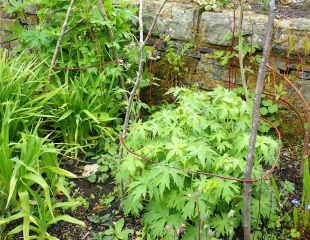
There are commercial plant supports available to stake Delphiniums and other perennials, but you can also make your own using bamboo canes/or stakes and string/hoops made of prunings.
In this image, tall stakes are used to make a framework and added around are hoops made from Cornus prunings. You need to cut the stakes to the ultimate size of the Delphinium and about 3/4/5 hoops or string wrapped around will need to be added to create a supportive cage. Check out plant supports for free.
Suggested Varieties of Delphiniums to Grow
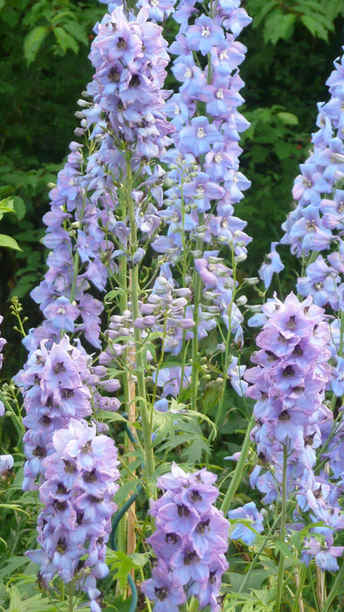
Delphiniums come in lovely shades of blue, white, pink and purple, and even yellow, often with a contrasting eye or 'bee'. Many Delphiniums are tall and for this reason look fantastic at the back of a border, although there are also more compact varieties, which, being smaller, need less support.
There are three main groups of Delphiniums:
- Belladonna which has single flowers and grows up to 1.2 m(3-4');
- Elatum group which has single, semi-double and double flowers with an eye and is commonly grown. In this group, there are small, medium and tall varieties growing from between 1.5m (5') -2m (6').
- Pacific hybrids which are short-lived annuals or biennials.
There are a number of Delphiniums which have the RHS award of garden merit, which is always a good starting point and worth checking out, which includes varieties such as D. 'Clifford Sky' strong blue, white eye semi double. D. Margaret, which is a lovely bold blue, D. Emily Hawkins a soft lavender and Elizabeth cook a white variety, there is a great number to choose from.
There is also a magic fountain series of Delphinium which are more compact in shades of blue, violet and white up to .5m.
How to grow Delphiniums from Seed
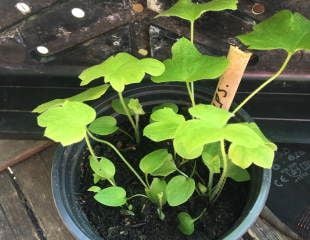
Delphiniums are surprisingly easy to raise from seed, and some varieties will flower the first year. Delphiniums plants are expensive to buy and it is worth trying to grow them from seed as they germinate easily and grow quickly into sturdy plants. They are a good plant to try your hand at if you have not grown from seed before.
You can start growing Delphiniums early in the year. Simply sprinkle the seed into small pots or a seed tray, cover with a little compost and spray to dampen. Either place in a propagator or make a small propagator by covering with a plastic bag held in place by an elastic band. This creates a better environment for germination.
As soon as the seedlings are established, take out of the propagator and grow on in a sheltered spot, ideally a greenhouse. When the seedlings are large enough to handle, as in the image, pot on into individual small pots and then into a larger pot. Once the risk of frost has passed, and the plant is of a reasonable size, plant out and protect from slugs. As with all seedlings, ensure they do not dry out.
And If the wind blows......
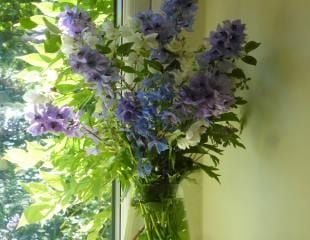
The up side to a summer storm which can snap Delphinium stems, is the chance to cut the flowers and bring them inside. Often even though the stem has snapped, the flowers look good, and they make a lovely display as in the image left some post storm Delphiniums. Home-grown flowers have many advantages. They are lovely and fresh, as nature intended, and are a sustainable garden choice, having travelled no miles, air or otherwise.
Climate change is now in the foreground, and as gardeners, we need to consider greener choices. Fewer flowers from Holland, and more from the garden, is a small, but constructive step. For tips about greener gardening, check out 10 top tips on sustainable gardening.
There is a revival in English cut flowers and some internet retailers are specialising in using, or using as much as possible flowers grown in the UK. Worth looking at are Great British Florist UK, Cornish Blooms and Flowers from the Farm, some food for thought next time ordering flowers on line.
